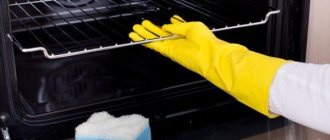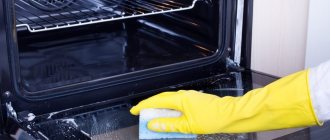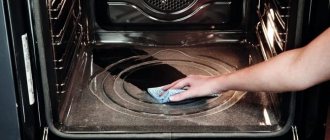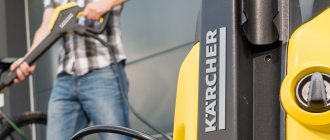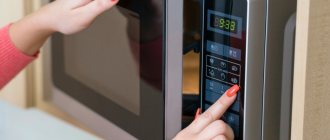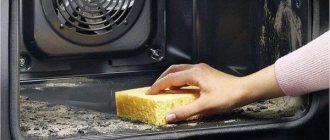Results: which oven is easier to use?
Gas and electric models of cooking cabinets have their own operational nuances, which are clearly displayed in the table
| Operating rules | Gas oven | Electric oven |
| Warm-up time (min) | 10-15 | 15-20 |
| Temperature setting | on a special scale, manually | according to a special scale |
| Level selection | top, middle, bottom | top, middle, bottom |
| Cooking modes | top and bottom heat, grill | top and bottom heat, grill, defrosting, heating, fan |
| Baking container | ceramic, fireproof glass, cast iron, silicone molds, foil or baking sleeve | ceramic, cast iron frying pans, refractory clay molds |
The choice remains with users who need to study the instructions in detail before using the unit. The main operating rules are set out above; using them means ensuring a long and trouble-free “life” of the equipment, obtaining excellent taste and appetizing appearance of dishes prepared in gas or electric ovens.
The process of creating dishes has long gone beyond ordinary cooking. This procedure can be attributed to a kind of creativity, as a result of which works of culinary art are born. And all this became possible only thanks to modern technology and new devices.
The most common and in demand is the oven. The special design of the oven makes it possible to create unique dishes that, in addition to their taste, are also healthy. But housewives are faced with the question: which electric or gas oven should they buy for their home? To understand it, you need to study the structure and operating principle of electric and gas furnaces.
Dishes in the oven
Dishes in the oven
Starting the oven for the first time in an electric stove
Before turning on this device, you should first remove all unnecessary items from it. Then, insert the plug into the socket and set the required mode on the device.
Now, having again heated the device to the required temperature, you can start cooking.
When handling the oven, you should be especially careful, remembering how hot its elements are. To avoid burns, it is advisable to use protective gloves when placing a container of food in the oven and removing it from there.
After the cooking time for the products placed in the oven has completed, you should turn the temperature regulator to position “0”, and after the oven has completely cooled down, clean it of any scale and grease that has formed on the walls. Don't forget to unplug it first.
Safety regulations
Regardless of the manufacturer of the electric stove and its model, when using the oven, you must familiarize yourself with and be sure to follow the following basic safety rules:
- Do not leave the operating device unattended for a long time;
- Do not allow children near the switched on device;
- The oven should be cleaned every time after cooking food in it, having first disconnected the appliance from the power supply;
- For cleaning, use only detergents permitted by the instructions for the device;
- Cool the oven only with the lid closed;
- Do not store flammable substances near the electric stove;
- It is prohibited to use the oven for purposes other than its intended purpose, for example, to heat a room;
- In the event of a breakdown, it is prohibited to disassemble and repair the device yourself; you must use the services of repair specialists.
If you follow these simple rules, the oven will serve you for many years and will delight you with delicious and aromatic dishes!
The principle of operation of a gas oven
To properly light the oven, we recommend studying the features of its operation.
Usually the air is heated from below. Next, the hot streams rise, evenly distributed over all areas of the oven.
On many devices, the oven has a separate burner through which gas flows. Engineers recommend purchasing panels that have diffusion burners installed. In them, gas and air are mixed naturally, without oxygen being sucked in.
The principle of operation of the technology is quite simple. To enable it you need:
- smoothly turn the tap responsible for supplying propane to the burner;
- open the door and use the auto-ignition button (older models use matches or a lighter) to light the fire;
- place a container with food inside, set certain parameters (temperature, mode, time, etc.).
Depending on the type of unit, the activation principle may differ. Therefore, technicians at technical centers recommend that you carefully study the operating instructions for the device before starting work.
Additional devices and options
We have figured out the variety of types and types of ovens, but this is not enough to choose an oven model, since there are a huge number of additional options that each manufacturer strives to increase. Let's look at some of the common options offered by manufacturers.
Convection
Convection is a heating mode in which hot air circulates throughout the oven. The convection heating mode of the oven is ensured by the operation of a fan located on the back wall of the oven
closet Thanks to convection, you can cook dishes on several levels at the same time and you don’t have to worry about baking evenly.
Grill
A grill is a gas, electric or infrared heating element located in the upper part of the oven that radiates heat in such a way that the food underneath quickly browns on top, while remaining tender and juicy inside.
Skewer
A spit is a device, often equipped with an electric motor, that allows you to cook barbecue or large pieces of meat, fish, and poultry by baking them evenly on all sides.
Oven with microwave function
The microwave function is the ability to use the oven as a microwave oven, and it is possible to combine it with other operating modes, such as grill and conventional. When using the microwave function, the cooking process is significantly accelerated. Read more…
Electric ignition of gas ovens
Electric ignition is a device that ignites the flame of gas burners without opening the oven door using an electric spark, which ensures the safety and convenience of using the oven. Electric ignition can be implemented automatically when switching the gas burner adjustment or as a separate button.
Telescopic guides
Telescopic guides are retractable runners on which baking sheets are placed. There are implementations of telescopic guides that extend out of the oven simultaneously with the opening of the door, which ensures the safety of checking the readiness of the dish and the convenience of using the oven, but the most common implementation is one that does not extend when the door is opened, but this simple design is very convenient to use, since there is no need to remove the baking sheet from the oven runners.
Timer
A timer is a device for programming time that allows you to timely control the degree of readiness of a dish and turn off the oven in a timely manner. There are models with an audible timer that only beep when the time has elapsed, and there are models with the oven automatically turning off.
Ability to program
There are models with a specific list of programs provided by the manufacturer, which allows you to automatically prepare various dishes or perform the operations necessary for their preparation, such as defrosting. There are also models that allow you to create your own cooking programs and save them in memory.
Tangential mechanism
A tangential mechanism is a mechanism that uses a cooling fan to supply cold air from the bottom up through the door's supply duct system to cool it by displacing heated air through an air duct located above the door, which also prevents the kitchen unit from heating up.
Pyrolytic cleaning
Pyrolytic cleaning is the most effective high-temperature automatic oven cleaning system, in which dirt burns, turning into ash, thereby eliminating the need to use special detergents, but not a damp cloth. Read more…
Catalytic purification
Catalytic cleaning is a system that uses fine-pored enamel with catalytic properties to accelerate the oxidation of fat and its breakdown into water and carbon. Unlike the pyrolytic cleaning system, in the catalytic system cleaning occurs during the cooking process at a working temperature of up to 200-250°C, but this does not eliminate the need to clean the working chamber with special means, but only reduces the frequency of their use. Read more…
We have provided only a small part of the most common and popular additional functions and options offered by manufacturers. At the same time, each manufacturer has its own unique options and functions offered to customers, which you can familiarize yourself with in the relevant sections:
- Popular models of Bosch ovens
- Popular models of Gorenje ovens
Rules for setting up an oven
Some users claim that burning occurs due to the fact that the stove has only a lower heating mode, the lack of precise temperature control and the operation of the convector, which is responsible for uniform cooking. And others argue that the reason is very poor build quality and the components themselves. But they are right only in rare cases, in fact, most often this happens due to choosing the wrong baking temperature and not following the recommendations for use.
Many people do not know how to properly use a gas oven. Even little things that we usually don’t pay attention to, such as an extra frying pan inside the oven or a broiler, can cause the pie to burn. What do you need to know before putting baked goods in the oven? You need to make sure that there are no unnecessary objects inside the oven that will interfere with air circulation. You need to preheat the oven. To do this, you need to set the temperature to the highest possible temperature for 15 minutes. After the temperature in the oven is adjusted to the required level, you need to wait a couple more minutes, and then place the baking sheet with the baked goods.
Tip: Each stove has its own instructions. To obtain perfect baked goods, you must read it carefully. Some models have their own characteristics that you need to be aware of when cooking.
To be sure that your dish will not burn, you need to place a baking tray with 1-2 kg. Coarse salt or sand, from the bottom of the oven. Salt will take away excess heat, which will allow your dish to cook completely and prevent it from burning. This can be repeated many times. As a result, the salt will turn into a crust, which will not affect its beneficial qualities.
For high-quality heat distribution, you can use a special baking stone or an ordinary red brick.
As everyone knows, the main disadvantage of gas stoves is uneven heating of food. This is due to the fact that the gas burns only from below. Masters can adjust the nozzles to distribute heat evenly, but a beginner should not meddle in there; it would be better to use the time-tested methods of housewives.
It can be very difficult in a gas oven - the bottom will burn, the top will not cook. But such situations can still be corrected, you just need to believe in yourself. At some points, you can simply put a brick or adjust the recipe a little.
Source
Safety rules when handling a gas oven
Any such equipment requires caution when operating. Propane, which is most often used in it, is a source of danger. This gas ignites quickly and leakage can cause an explosion.
Therefore, technical center engineers recommend handling it carefully, following safety rules.
- Ventilate the unit before each use. It can accumulate propane, which can easily ignite if it comes into contact with fire. This often leads to burns.
- Monitor the distribution of the flame around the perimeter of the burner: it should be evenly throughout the entire burner, without empty gaps.
- Do not use the oven to heat the room.
- Several times a year, call a service center employee to diagnose the equipment and check the tightness of the hoses.
- Clean the device regularly. Try to avoid large contaminations. After each cooking, carry out a wet cleaning, cleaning the device from food residues and deposits. Otherwise, they may clog the holes in the slab and cause damage.
- If you smell propane, open your windows immediately. Do not use open flames under any circumstances. Try to find the source of the smell and call a technical service representative.
Electric oven
Electric ovens can be built into the stove or sold separately from the hob. It makes no difference what brand the oven is: Bosch, Gorenje. Getting started is the same for everyone. Carry out the “firing” as described above, study the instructions and control panel. In the photo you can see the control panel of the Gorenje stove.
Turning on an electric oven is easier than a gas oven; you just have to turn the knob to the desired mode and wait for it to heat up.
Many models have additional features:
- timer,
- alarm,
- operation of only the upper or lower heating element.
An alarm clock differs from a timer in that it only notifies when a dish is ready. The timer turns off the temperature mode after the time has expired. In Bosch and Gorenje ovens, the thermostat knob can be set to zero 10 minutes earlier - that’s how long the heat will remain inside the cabinet. To prevent the glass from fogging up, leave the light on.
Pies in an electric oven
Some features of the operation of stoves of various brands
There are dozens of brands and hundreds of models on the market, but there are only a few truly unique designs. Below, brands are grouped based on similar oven control techniques.
How to properly turn on the built-in oven in a modern electric stove Bosch, Siemens, Samsung, Electrolux
Electric oven Bosch
The sequence of actions for Bosch, Siemens, Samsung, Electrolux stoves is as follows:
- select the required cooking mode: heating temperature and baking duration;
- set the desired value on the temperature regulator;
- place the dishes with food at the required height and close the door tightly;
- set the cooking time on the timer;
- follow the indicator on the panel for the remaining time, if the recipe requires intermediate actions with the dish: turn over, pour over the sauce, add ingredients;
- At the end of cooking, when the timer signal sounds, you should remove the dishes with the prepared dish and clean the cabinet of dirt as soon as possible.
If you leave cleaning until later, food particles and splashes of fat and sauce will cake, forming a hard-to-remove residue.
How to safely turn on and off an Ariston and Indesit gas oven
Gas ovens Ariston and Indesit are distinguished by their affordable price and at the same time high quality and safety in operation. With any ignition method - automatic or manual - you must make sure that gas combustion has started and is stable. In models with piezo ignition, simply turn the control knob to the maximum temperature zone and press it.
The igniter is marked in red, electric ignition in green.
- In budget models with manual ignition, you need to turn the knob, press it, ignite the gas through the pilot hole and hold the knob pressed for at least 15 seconds. During this time, the safety system will work and gas will be supplied to the burner. If you release the handle earlier, the security system will shut off the supply.
Indesit control panel
The oven should be lit with the door completely open.
How to turn on a gas oven Gorenje, Darina, Hephaestus
Gas ovens of the Gorenje, Darina and Gefest brands are equipped with similar safety systems, and ignition is carried out in the same way. The door must be opened completely.
Systems equipped with electric ignition are ignited by turning the knob counterclockwise, pressing the knob and holding it pressed for 20 seconds.
If you turn the control in the opposite direction, clockwise, and do the same steps, the grill will turn on.
Checking the ignition of the Gefest stove
For models not equipped with electric ignition, you will have to use long gas matches or a kitchen lighter.
Beko
For Beko gas devices, the sequence of actions is exactly the same as described above, but holding the regulator knob down for 5-10 seconds is enough.
Fans of rich desserts and baked-stewed delights have probably more than once encountered a situation when, after preparing a dish, the result does not meet expectations. Why did the picture show a beautiful fluffy pie, but in the end it turned out to be a flat cake? Here it is not only a matter of the correct selection of ingredients, but also the correct use of a gas or electric oven.
The design of these two options for culinary cabinets has general operating rules, as well as nuances for each type of device. Even beginners can master these aspects; the main thing is to study the instructions for the desired model and learn how to use the equipment in order to reveal all its strengths.
Lighting the oven
A gas oven heats up quickly compared to an electric oven, which is necessary for quick cooking. The equipment is used to heat food even if the lights are turned off in the house.
How to light a gas oven? First you should check whether the equipment is connected to the gas system. It is also necessary to familiarize yourself with the images on the plate. You need to pull out the metal bottom. Inside there will be a burner with curved holes for the flame to escape. There are 1 or 2 holes for ignition. A match is brought to them, and at the same time the relay turns.
How to light a gas oven if it has an ignition button. The burner tap must be turned to set the required temperature. Then press the gas supply start button. And the fire is activated by another button, which is located on the side of the panel. If there is no gas for several seconds, then turn off the equipment and repeat the procedure.
Safety requirements
Using an electric oven is not difficult, but it is important not to neglect safety.
Observe the following rules:
- do not use the oven without grounding;
- do not leave operating equipment unattended;
- do not cook in containers that are not intended for high temperatures;
- do not keep flammable objects and liquids nearby;
- Only process and wash the oven when it is de-energized.
Check the oven's power cord periodically. If there are wiring problems or malfunctions, do not use the device until the problem is resolved.
Oven position
The oven chamber has several guides for positioning baking sheets and racks at different levels. The most optimal position is to place the dish on the middle level, because this is where the product is cooked evenly and correctly.
During baking or stewing, the dish can be moved downward if the top is too browned or upward if you want a crispy crust.
Oven functions
If the oven does not have a “Grill” mode, then an equally tasty dish can be obtained using universal heating. When large pieces of meat or fish are baked, you need to control the process during cooking. The pieces should be watered with the released juice.
In addition to the classic method, you can bake dishes in the oven using an artificial shell, such as foil or a bag. The first material is used for cooking meat, fish, and vegetables. If foil is used, it is important to follow a simple rule: the shiny surface should be turned toward the dish, and the matte surface should be turned outward.
The bag is great for baking a dish along with a side dish, you just need to make holes in its walls in advance. This procedure allows you to cook food juicy and soft. You can cook porridge and soup in the oven, which gives the dish a wonderful taste.
